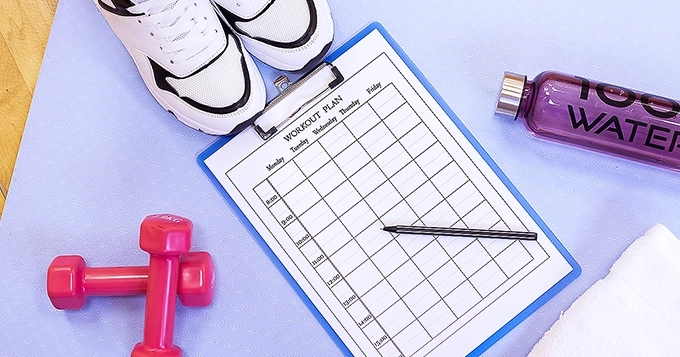“How often should you exercise?”
It’s a common question in the fitness community. And it’s probably why you’re here. Well, you’re in luck! This article might help you know how often you should hit the gym to reach your fitness goals.
Exercise is an effective way to stay healthy. Especially if you keep a regular schedule and stay consistent with it. However, how much exercise do you actually need per day and per week, and can you realistically apply these healthy guidelines to your daily life?
Let’s discover the ideal amount of workout for your optimal health. But first, let’s discuss why it’s important to get enough exercise.
Health Benefits of Getting Enough Exercise
No matter how old you are, your fitness objectives, or your current health situation, staying active is crucial for your health.
- Exercise boosts the immune system.
Exercise boosts your immune system, contributing to your overall health. Research published in the Journal of Sport and Health Science in 2019 reveals that exercise can strengthen your immune response, decrease illness risk, and lessen inflammation. As muscles contract during exercise, blood and lymph flow increases, allowing your immune cells to circulate more efficiently throughout the body.
Exercising consistently can improve the body’s ability to combat sickness-causing germs. This helps the immune system monitor and detect potential threats, such as bacteria and viruses.
- Exercise benefits cardiovascular health.
The primary cause of death for adults is heart disease. To mitigate the risk of developing heart disease, you can improve your cardiovascular health by doing exercises. It helps improve cholesterol and blood pressure levels, two of the most significant contributing factors for heart disease.
- Exercise improves mood.
Exercise how many times a week to start seeing improvement in your moods?
Studies have indicated that engaging in low-intensity aerobic exercise for 30 – 35 minutes, 3 – 5 days per week, for 10 – 12 weeks, was most effective in boosting positive moods.
Exercise boosts blood flow, and this circulation ensures that your brain receives enough oxygen, which in turn fuels your mental energy. As a result, it reduces stress, anxiety, and depression while boosting mood, cognitive function and self-esteem.
- Exercise strengthens bones and muscles.
Your muscles and bones get stronger when you work out regularly. But if you don’t move and stay lazy, they lose their power. So, when you exercise, your muscles become mighty and pull on your bones, making them stronger too. This helps you stay active and do all your daily tasks with ease!
- Exercise improves sleep quality.
How often should you exercise to improve your sleep quality? Research indicates that engaging in moderate-intensity physical activity for a minimum of 30 minutes daily can enhance sleep quality.
If you start exercising today, it will help you sleep better tonight. Exercise is beneficial for both your mind and body, and it can improve your sleep, too. Aside from exercise, to get the best sleep, remember to:
- Avoid caffeine after lunch.
- Eat a light dinner, not heavy meals that keep you awake.
- Avoid consuming alcohol before bedtime.
Recommended Exercise per Week
How often should you exercise a week?
It shouldn’t be a surprise that physical activity is something we should undertake on a weekly basis given the extensive list of health advantages associated with exercise.
The current Physical Activity Guidelines for Americans from the U.S. Department of Health and Human Services (HHS) recommends that adults should at least engage in 150 minutes per week of moderate or 75 minutes per week of high-intensity aerobic physical activity.
Adults also have muscle-strengthening activities at least twice a week, such as weightlifting or resistance training.
The Centers for Disease Control and Prevention (CDC) suggests a mix of weekly aerobic training and muscle-strengthening activities. Aerobic training can help you manage your blood pressure and blood sugar, while muscle-strengthening activities support strong bones and muscles.
Here is a list of examples of different types of workouts:
Moderate aerobic training:
- Doubles tennis
- Riding a bike on flat ground
- Brisk walking
- Water aerobics
- Ballroom dancing
Vigorous aerobic training:
- Basketball
- Jogging
- Hiking uphill
- Running
- Swimming laps
- Singles tennis
- Jumping rope
How much moderate exercise is recommended per week? Each week, adults need 150 minutes of moderate-intensity physical activity.
Muscle-strengthening activities:
- Body-weight exercises (push-ups, sit-ups, and squats)
- Certain types of yoga
- Working with resistance bands
- Gardening
- Lifting weights
According to the current Physical Activity Guidelines for Americans, doing 2 days of muscle-strengthening activity is recommended.
Recommended Exercise per Day
For moderate aerobic training, you can split 150 minutes into 30 minutes a day, while for vigorous aerobic training, you can opt for 15 minutes daily.
As an example, you could engage in brisk walking for 30 minutes daily, five days a week. On the other two days, you can perform body-weight exercises or weight lifting.
It is alright if you occasionally skip a workout even brief five-minute movement sessions are more advantageous than no activity at all. You can divide your 75-150 minutes of weekly aerobic exercise at your convenience. Your workout routine must not be consistent each day or week to be effective. In fact, both your body and mind benefit from workout variety.
The key benefits of exercise stem from increased muscle work, breathing, and heart rate during activity, so feel free to alternate between different activities like cycling, hiking, jogging, gym workouts, or home dance classes. Keep moving.
Should everyone exercise the same amount?
The recommended amount of exercise per week is 150 minutes, but this is not a one-size-fits-all recommendation, as with all health-related activities and suggestions. It is more of a starting point instead.
Some individuals, such as the elderly or those with long-term illnesses, injuries, or physical disabilities, could have different needs. Consult a medical professional to find out how much and what kind of exercise is safe for you if any of these conditions apply to you. Similarly, if you’re not used to working out at all.
Reduce the amount of time you spend moving in this condition and consider low-impact or low-intensity workouts. This way, you can concentrate on frequency and develop the habit before addressing other aspects like intensity and duration.
How to Get Enough Exercise
It’s natural to feel challenged on how to fit exercise into your routine, especially if you’re a fitness beginner or have a packed schedule.
Don’t limit yourself to just walking. To meet the recommended exercise duration, engage in moderate-intensity activities like casual biking, leisurely swimming, gardening, or vacuuming.
You can incorporate daily activities like:
- Use stairs instead of elevators
- Take the bike instead of your car
- Play a sport (table tennis, basketball, badminton)
- Start your day with a morning exercise before you get busy
- Do a workout at home
- Park somewhere relatively far, then walk to your destination
For better results, be consistent with your exercise routine. To track your progress, monitor your achievements to stay motivated and adjust your routine as needed.
When is the Best Time to Exercise?
To incorporate daily exercise into your routine, you can consider your work schedule and daily activities to find suitable time slots for exercise. You can divide your day into three parts and aim for 10 minutes of walking each time. For example, after waking up, during lunch, and after dinner. If home constraints limit your flexibility, set a timer on your phone for every 90 – 120 minutes to remind you to take a 5 to 10-minute walking break.









